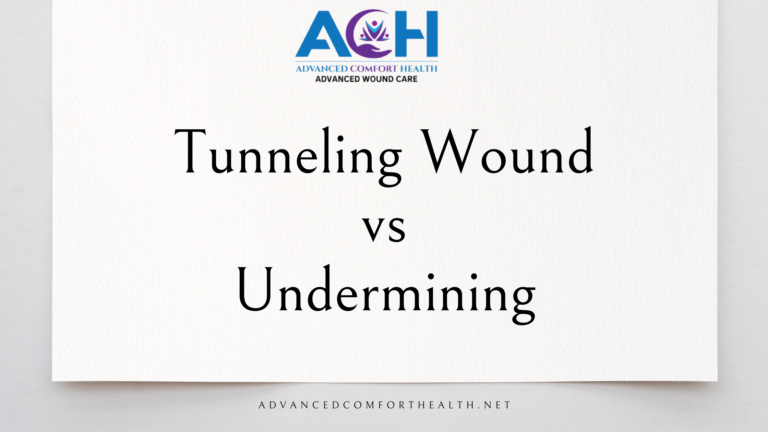Managing a wound can be complicated and requires much care and effort. Tunneling wounds and undermining are two common phenomena encountered in wound care. Wounds can develop complications, including tunneling and undermining. Understanding tunneling wounds vs Undermining is crucial for healthcare professionals to manage and treat wounds effectively. This blog is specifically designed to understand tunneling wounds vs undermining, their definitions, causes, risk factors, and implications for wound closure.
What Is Undermining and Tunneling Wound?
Undermining occurs when there is a separation of the skin from the underlying tissue, creating a space around the wound’s edge. This space allows the wound to spread laterally beneath the surface of the skin.
On the other hand, a tunneling wound is a type of wound characterized by narrow passageways or channels that extend from the wound surface into deeper layers of tissue. These tunnels can create challenges in wound management and healing, as they may harbor bacteria, impair tissue granulation, and hinder the effectiveness of wound care interventions.
Difference Between Tunneling Wound and Undermining?
For effective wound management, it is necessary to understand the differences between tunneling wounds and undermining. Tunneling extends in one direction from the wound, whereas undermining occurs around the wound’s perimeter.
Another major difference is in the appearance of these conditions. Tunnels often appear as tracts going into the tissue from the wound. Undermining creates a space around the wound’s edges.
Both have a complicated impact on the wound-healing process, increasing the risk of infection.
If you or a loved one is struggling with wounds requiring expert care, consider reaching out to ACH, our mobile wound care clinic. Let us provide the specialized attention and treatment needed for optimal healing. Contact us today to schedule a consultation.
What Causes Wound Undermining?
For a better understanding of wound undermining, it is crucial to appreciate various factors that come together and result in the undermining of the wound.
-
Pressure on the skin
Shearing forces onto the skin often from prolonged immobility can result in the undermining of the wound. When force is applied to the skin, especially at the bony prominences, it results in the deformation of tissues. This deformation leads to the sliding of tissue layers. This force can result in the separation of deeper tissues resulting in an undermined wound.
Tissue ischemia and necrosis can also occur as the blood flow is compromised due to pressure forces. If left untreated, it can result in serious complications such as infection and delayed healing.
-
Infections
Our body initiates an inflammatory response whenever gets infected. This inflammatory response can result in tissue swelling and edema. Due accumulation of fluid in tissues often results in the separation of tissues, creating an undermining wound. This inflammatory phase often prolongs resulting in delayed tissue repair and regeneration. Infections can also compromise the tissue blood flow to the wound site which can weaken the tissue and contribute to the undermining of the wound.
-
Inadequate treatment or improper wound care.
If the underlying causes of the wound, such as poor circulation, pressure, or trauma, are not adequately addressed, the wound may continue to deteriorate. Without addressing these underlying issues, the wound may remain susceptible to further damage and undermining. Poor patient compliance such as failure to keep the wound clean and dry or to adhere to offloading recommendations, can interfere with the healing and exacerbate undermining.
What Is Undermining for Wound Closure?
undermining for wound closure is a valuable technique that can enhance the outcomes of surgical procedures and improve the cosmetic appearance of wounds. During undermining, a surgical instrument such as a scalpel or scissors is used to create a subcutaneous space beneath the intact skin surrounding the wound. This creates mobility in the skin, making it easier to bring the wound edges together without tension. By reducing tension at the wound site, undermining helps to minimize the risk of wound dehiscence (opening of the wound) and improves the cosmetic outcome of the closure.
Undermining may also facilitate the removal of scar tissue or unhealthy tissue, allowing for a cleaner wound bed and promoting better wound healing. Additionally, it can enhance the vascular supply to the wound edges, which is essential for tissue viability and optimal healing. The depth and extent of undermining depend on various factors, including the size and location of the wound, the condition of the surrounding tissue, and the surgical technique employed. Careful consideration is given to preserving the blood supply and minimizing trauma to surrounding structures during the undermining process.
After undermining is completed, the wound edges can be approximated using sutures, staples, or adhesive strips, depending on the preference of the surgeon and the specific requirements of the wound. Following closure, appropriate wound care and postoperative Management is essential to promote successful healing and minimize the risk of complications.
What Does Undermining Mean in Pressure Ulcers?
In pressure ulcers, undermining can develop as a result of constant pressure and shear forces on the skin, causing the wound to spread laterally beneath the surface. This can make the ulcer more challenging to treat and increase the risk of infection. Undermining in pressure ulcers often occurs around the wound periphery, particularly over bony prominences where pressure is most concentrated.
The presence of undermining in pressure ulcers indicates a more advanced stage of tissue damage and can significantly impact the wound healing process. The undermined tissue creates a pocket or space beneath the wound, compromising blood flow and nutrient delivery to the affected area. This impaired tissue perfusion can lead to tissue ischemia, delayed wound healing, and increased susceptibility to infection.
Effective management of undermining in pressure ulcers requires a comprehensive approach that addresses both the underlying causes of pressure injury and the specific characteristics of the wound. This may include offloading pressure from vulnerable areas, optimizing wound care techniques, implementing infection control measures, and promoting tissue regeneration.
Regular assessment and monitoring of pressure ulcers are essential to detect undermining early and intervene promptly to prevent its progression. Healthcare professionals should conduct thorough wound assessments, including careful inspection and palpation of the wound bed, to identify signs of undermining and guide appropriate treatment decisions.
Risk Factors of Tunneling and Undermining Wounds
Chronic diseases: Conditions like diabetes can impair healing and increase the risk of complications. Individuals with chronic diseases should receive specialized wound care to mitigate the risk of tunneling and undermining. If you’re struggling with wounds related to chronic conditions, consider seeking expert care from ACH, our mobile wound care clinic. We offer tailored treatment plans to address your specific needs and promote optimal healing. Contact us today to schedule a consultation.
Poor circulation: Reduced blood flow can hinder wound healing and promote the formation of tunneling and undermining. Patients with compromised circulation should receive prompt evaluation and intervention to improve blood flow and prevent further tissue damage.
Our mobile wound care clinic provides comprehensive vascular assessments and specialized wound care to address circulation issues and facilitate healing.
Conclusion
A proper understanding of tunneling wound vs undermining is crucial for effective wound management. Identifying the presence of these complications early can help guide treatment and improve outcomes for patients. By recognizing the signs of tunneling and undermining, healthcare professionals can implement targeted interventions to address underlying issues, promote wound healing, and prevent further complications.
Comprehensive wound assessment and regular monitoring are essential components of wound care protocols. Healthcare providers must remain vigilant in assessing wounds for signs of tunneling, undermining, or other complicating factors. This proactive approach allows for timely intervention and adjustments to treatment plans, reducing the risk of progression to more severe wound complications. Together, we can work towards achieving the best possible outcomes and improving the quality of life for individuals living with wounds.
FAQs
Q: What is a tunneling wound, and how does it differ from other types of wounds?
A tunneling wound is a type of wound characterized by narrow passageways extending from the wound surface into deeper tissues. These tunnels can be complex and may branch out in different directions. Unlike other wounds, tunneling wounds present with distinct channels within the wound bed.
Q: What causes tunneling wounds to develop, and are there any specific risk factors?
Tunneling wounds can develop due to various factors such as prolonged pressure, shear forces, friction, trauma, or impaired wound healing. Specific risk factors include immobility, poor nutrition, diabetes, peripheral vascular disease, incontinence, advanced age, smoking, compromised immune function, and certain medications.
Q: How are tunneling wounds diagnosed by healthcare professionals?
Healthcare professionals diagnose tunneling wounds through a comprehensive assessment, which may include a visual examination, probing the wound with a cotton-tipped applicator, or using diagnostic tools like ultrasound to visualize the extent of tunneling.
Q: What are the potential complications associated with untreated tunneling wounds?
Untreated tunneling wounds can lead to further tissue damage, infection, delayed wound healing, and the formation of chronic wounds. In severe cases, tunneling wounds may extend deeper into vital structures, increasing the risk of complications such as osteomyelitis or sepsis.
Q: What are some effective treatment options for tunneling wounds, and how do they work?
Treatment options for tunneling wounds typically include wound debridement to remove necrotic tissue, wound packing to fill the tunnels, and appropriate wound dressings to promote granulation tissue formation and wound healing from the bottom up. Surgical interventions may be necessary in complex cases.
Q: Can tunneling wounds heal completely, and if so, what factors contribute to successful healing?
Yes, tunneling wounds can heal completely with appropriate wound care and management. Factors contributing to successful healing include addressing underlying causes, optimizing nutrition, maintaining proper wound hygiene, promoting tissue regeneration, and preventing infection.
Q: What steps can be taken to prevent the formation of tunneling wounds in at-risk individuals?
Preventive measures include regular skin assessments, implementing pressure redistribution strategies, optimizing mobility, maintaining adequate nutrition, managing incontinence effectively, and educating patients and caregivers about proper wound care techniques.
Q: Are there any specific wound care techniques or products recommended for managing tunneling wounds?
Effective wound care techniques for managing tunneling wounds include meticulous wound cleansing, proper wound packing to fill the tunnels, selecting appropriate wound dressings based on the wound characteristics, and ensuring adequate wound offloading.
Q: How long does it typically take for a tunneling wound to heal, and what factors can affect healing time?
The healing time for tunneling wounds varies depending on factors such as wound size, depth, severity, underlying health conditions, and adherence to treatment protocols. While some tunneling wounds may heal within weeks with appropriate care, others may require months of treatment.
Q: What should I do if I suspect that I have a tunneling wound or if a wound is showing signs of tunneling?
If you suspect you have a tunneling wound or notice signs such as the presence of narrow channels within the wound bed, increased wound depth, or delayed healing, it’s essential to seek medical attention promptly. A healthcare professional can conduct a thorough assessment and develop an appropriate treatment plan tailored to your specific needs.

